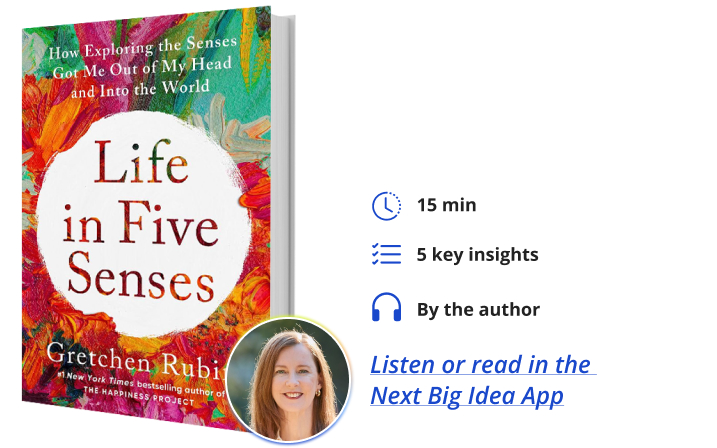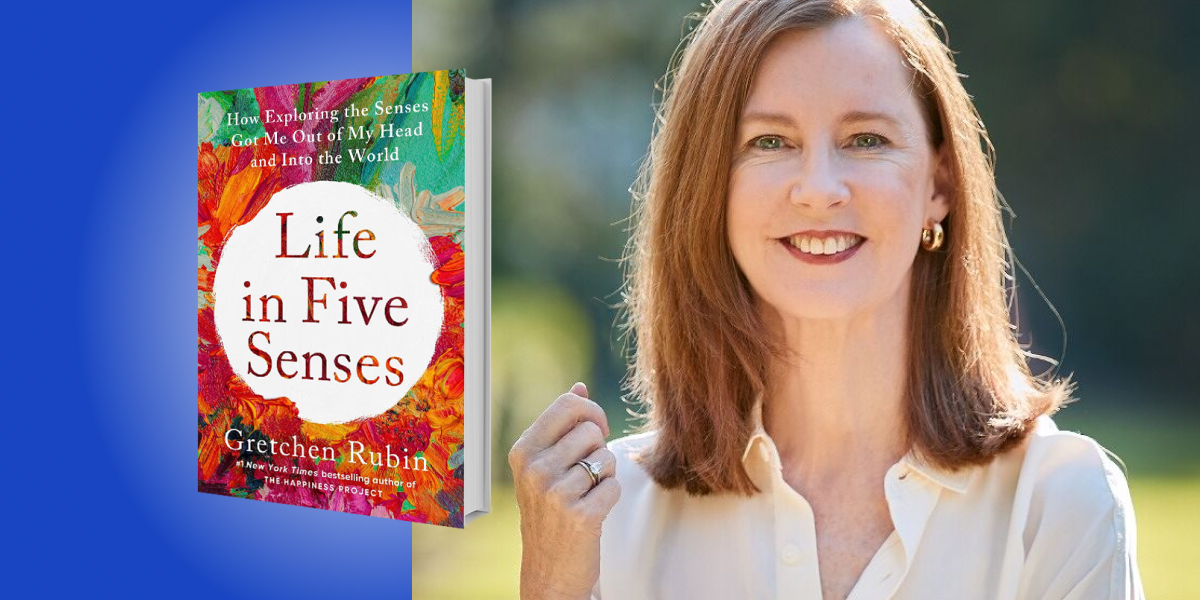Gretchen Rubin is a #1 New York Times bestselling author who studies happiness and human nature. Her books have sold more than 3.5 million copies worldwide, in more than thirty languages. She is also the host of the popular podcast Happier with Gretchen Rubin and the founder of The Happiness Project.
Below, Gretchen shares 5 key insights from her new book, Life in Five Senses: How Exploring the Senses Got Me Out of My Head and Into the World. Listen to the audio version—read by Gretchen herself—in the Next Big Idea App.

1. We can turn to our senses for surprising strategies to find more energy and self-renewal.
Instead of passively enduring the sensations around us, we can actively shape them. For instance, I could boost my energy by drawing on the power of my sense of hearing, through music. Research shows that music has a dramatic influence on our bodies, minds, and behavior. Listening to music during medical procedures can lower a patient’s heart rate, blood pressure, and anxiety level. Listening to music during exercise boosts performance and makes exertion seem less strenuous. Music improves our health, and it also makes us feel good. There’s a reason why we talk about “sex, drugs, and rock & roll;” hearing a favorite song stimulates the same brain chemicals as drugs, sex, and good food. That’s why it’s one of the quickest ways to get a mood boost and relief from stress.
I’d never listened to much music, and I wanted to tap into this power, my sense of hearing. I decided to create an “Audio Apothecary,” a special playlist of songs to cure the blues and give me a boost. For inspiration, I listened to Dolly Parton singing “Mule Skinner Blues.” It made me so happy to hear this cheerful, yodeling song—that song was the first addition to my “Audio Apothecary.” Over time, I added more songs, and now I can turn to my sense of hearing whenever I need an immediate jolt of energy. We can turn to other senses as well, for instance, by taking a quick sniff of fresh grapefruit, clean towels, vanilla, or a bookstore. We can revel in the luxurious cushion of new cotton socks or the cool, rough texture of a lamppost and, with these sensations, wake ourselves up.
2. We use our senses to help ourselves feel calmer and more focused.
If we want to combat stress and distraction, we can turn to our sense of touch. Little kids, for example, hang on to stuffed animals for comfort and reassurance. These days, we’re familiar with touch items like pop toys, fidget spinners, therapy dough, and weighted blankets. Without quite realizing it, I’d found my own way to use my sense of touch to calm down—by holding a prop. When I’m in a stressful situation, such as being backstage before giving a big talk, or walking into a party where I don’t know anyone, I hold a pen. I don’t have any paper, and if I need to take notes, I could use my phone, but holding a pen makes me feel grounded. When I asked around, I discovered that many people use props to help them manage anxiety, items like a mug, a clipboard, or a cold water bottle.
“When we identify what works for us, we can shape our surroundings to suit ourselves.”
Similarly, we can tap into our sense of hearing. Different sound environments help people to stay focused and productive. I work best either in silence or in a busy hum, like a coffee shop or an airport waiting area. Other people prefer to listen to music as they work, and of those people, some prefer music with words, and others, without words. Some people use different sound environments depending on what kind of work they’re doing. When we identify what works for us, we can shape our surroundings to suit ourselves.
Just as we clear clutter from our sight to help us focus, we can clear clutter from our hearing. We can play white noise, pink noise, or green noise to create a more consistent sound environment. We can wear noise-canceling headphones, or turn off smartphone notifications sounds so those pings won’t interrupt a train of thought. Speaking of smartphones, one easy way to make a smartphone a less tempting distraction is to switch the screen to grayscale. When a phone display is limited to black, white, and gray, it feels more utilitarian and less playful. Social media and photos are far less compelling, apps are harder to use, and everyday tasks are harder to perform, making the phone much easier to put down.
3. We can tune into our senses for more fun and pleasure.
It comes as no surprise that our five senses can be a big source of enjoyment for us. For example, when it comes to taste, many people love taste-related activities such as cooking, exploring farmers’ markets, trying new restaurants, or even watching TV shows about cooking and eating. However, we often neglect at least one of our senses, and it’s useful to understand which one. Once we stop neglecting it, we can find new sources of comfort, calm, creativity, delight, and love.
I wasn’t surprised to learn that taste was my most neglected sense. I ate the same foods most days and didn’t pay much attention to what I put in my mouth. I wanted to tap into my neglected power of taste so, just for the fun of it, I decided to throw a “Tastes Party” where my friends and I compared different tastes. We rated varieties of foods, like apples and potato chips, and I had my friends try a mystery drink (spoiler alert, it was Red Bull). We experienced the magic of ketchup—Heinz Ketchup is the rare food that encompasses each of the five basic tastes of sweet, sour, salty, bitter, and umami. Doing these taste tests was tremendously fun. My friends and I weren’t just socializing; we were sharing a sensory experience, and it got us all laughing and talking.
Also, as illustrated by Marcel Proust’s famous bite of his tea-soaked madeleine cookie, our five senses tie us to memories. Asking my friends about their taste memories was a great way to get to know them better, with questions such as, “What junk food did you love as a child but your parents would never buy you?” or, “What taste did you once enjoy that you now dislike?” These kinds of questions are also a good way to connect with co-workers or new acquaintances because they invite us to share memories that are personal without being uncomfortably revealing. One secret to getting more fun out of life is to tune in to our five senses.
4. Our senses can help spark our creativity.
Research shows that breaks from mental effort help us to stay productive and creative, and so insights often emerge during times when our minds roam freely. These could be the moments before getting out of bed in the morning, in the shower, or during exercise.
“I discovered that for many people, including me, making direct contact with tools and raw ingredients sparks the imagination.”
I’m a very disciplined person, so I wanted to find a way to let my mind off the leash, to give myself the feeling of recess. Given my nature, I needed to schedule time to wander, so I decided to visit the Metropolitan Museum every day for a year. With these daily visits, I used my love of discipline to give myself a break from discipline, and they gave me the feeling of recess. These visits were daily, unstructured, creative, and playful. I wasn’t trying to achieve some practical purpose, like improving my concentration or directing my awareness, and I didn’t have to follow instructions; I was enjoying each of my five senses. Other people use meditation to help them train their thoughts; I used recess to release my thoughts, the opposite of meditation.
Often I had my best ideas or most unexpected insights during these visits to the Met. The walking, the time outside, the spectacle, the learning—all contributed to my desire to create. However, while I’d expected that I might want to create an imitation of what I saw, this experience actually fed my desire to create with words—my usual medium. For example, I got the idea for my next book project while I was walking through a gallery of Roman art. I loved my visits to the Met so much that I continue to go every day, even now that the year of my experiment is long past.
I also found another quick way to boost my creativity. I discovered that for many people, including me, making direct contact with tools and raw ingredients sparks the imagination. As writer and monk Yoshida Kenkō observed, “If we pick up a brush, we feel like writing; if we hold a musical instrument in our hands, we wish to play music.” Visiting a hardware store, a farmers’ market, or an art-supply store is a great way to spark ideas. Putting materials into our hands often puts ideas into our heads.
5. Through our senses, we can find new ways to draw closer to the people we love.
Ancient philosophers and contemporary scientists agree: to have a happier life, we need strong, intimate bonds. We need to be able to confide; we need to be able to get and give support; we need to feel like we belong. Any practice that deepens or broadens our relationships with other people is likely to make us happier.
As I tuned into my five senses, I became much more aware of the people around me. I noticed how my father’s posture improved after he started targeting different muscles during his workouts, and how a friend started using words like “deliverables,” “stakeholders,” and “bandwidth” after he took a new job. Picking up on these little details made me feel more attuned to the people who were important to me.
“Any practice that deepens or broadens our relationships with other people is likely to make us happier.”
What’s familiar is easy to ignore, and I realized that for a long time, I’d been making a mistake in my marriage. I hadn’t been paying close attention to my husband Jamie, so I started tuning in to my five senses to really notice him. For instance, for several mornings in a row, as I made my morning coffee, I’d picked up a peanut butter-covered spoon and rinsed it off. It was only on the fourth morning that I thought to ask Jamie, “Have you been having trouble sleeping?” A spoonful of peanut butter is his favorite midnight snack, but I hadn’t noticed this clue sitting on the kitchen counter; I’d looked at the spoon without seeing it. When I knew to ask the question, Jamie told me that a difficult work problem was keeping him awake. Looking harder at the outer Jamie gave me an insight into the inner Jamie.
When I began my explorations, I’d hoped that through my senses, I could knit my body and mind together for a greater sense of energy, playfulness, and connection, leading to more vitality—but my results wildly exceeded what I’d expected. I learned that when we tune in to our five senses, the present feels more vivid. We experience each moment more mindfully, which makes us feel more connected to our past, feeling both calmer and more energetic. We have more moments of fun, delight, and awe, because the world is suddenly richer. Best of all, our five senses can help us pay more attention to the people we love.
Recognizing that people experience sensations in different ways can help us all to be more understanding. Not to dismiss people’s objections to sights, sounds, smells, tastes, or touches, but instead to respect them, so that we can create sensory environments in which everyone can feel comfortable. My exploration of the five senses has transformed my life. Every day, I tap into their power to connect me to the people, places, and ordinary moments that I want to experience and remember—and I’ll never take ketchup for granted again.
To listen to the audio version read by author Gretchen Rubin, download the Next Big Idea App today:





























